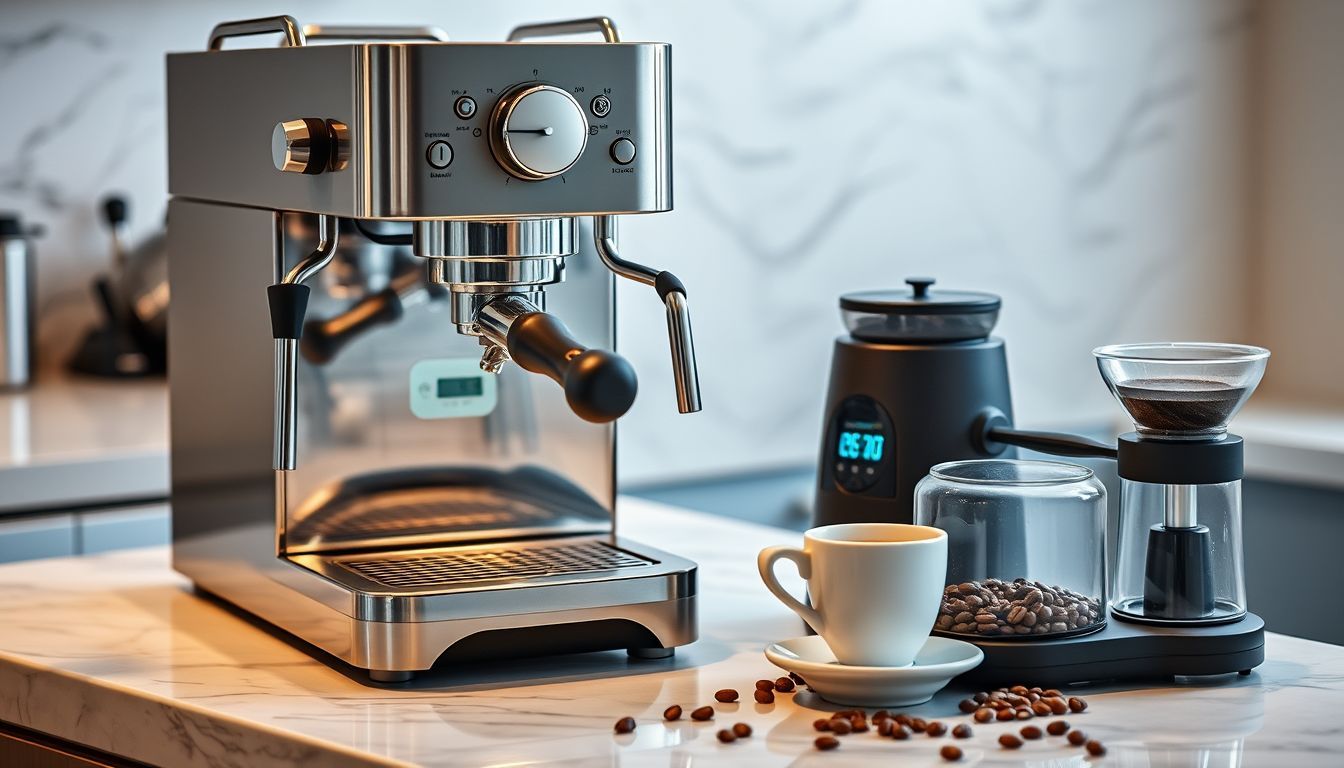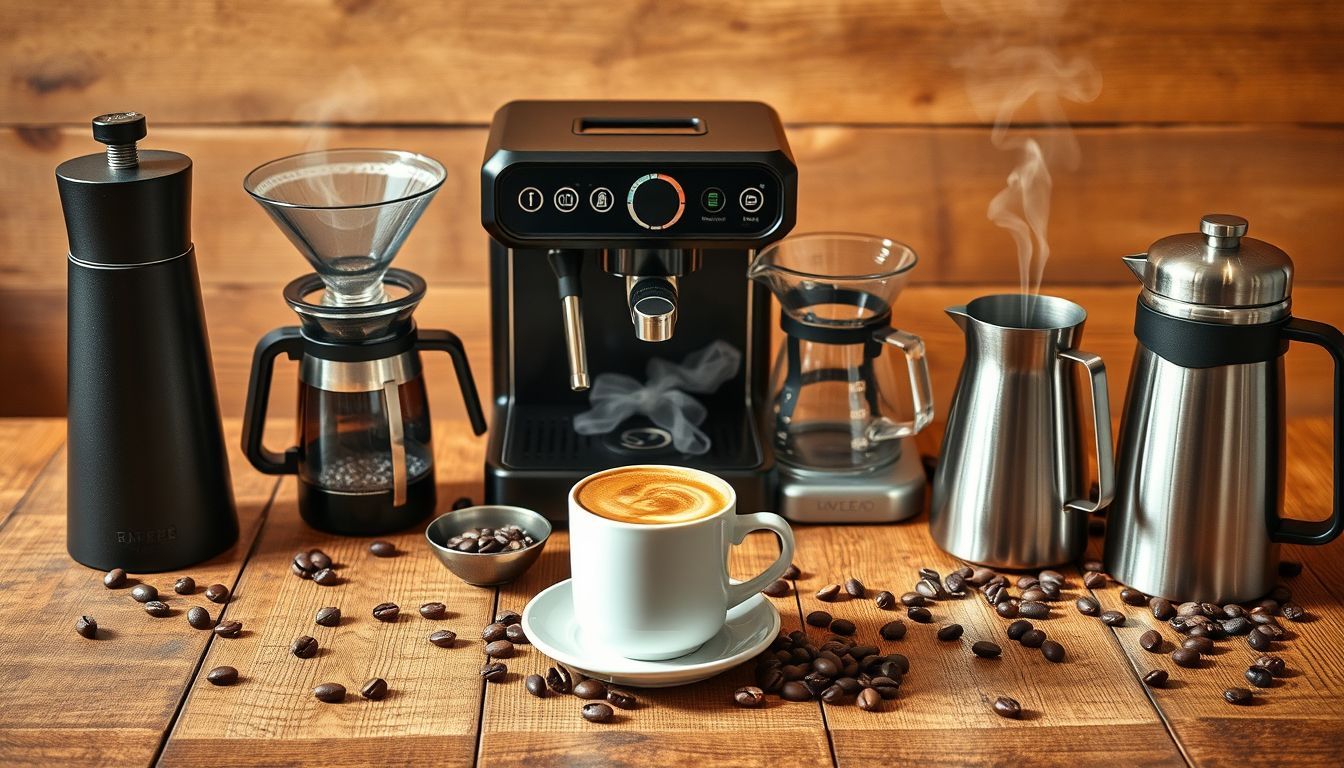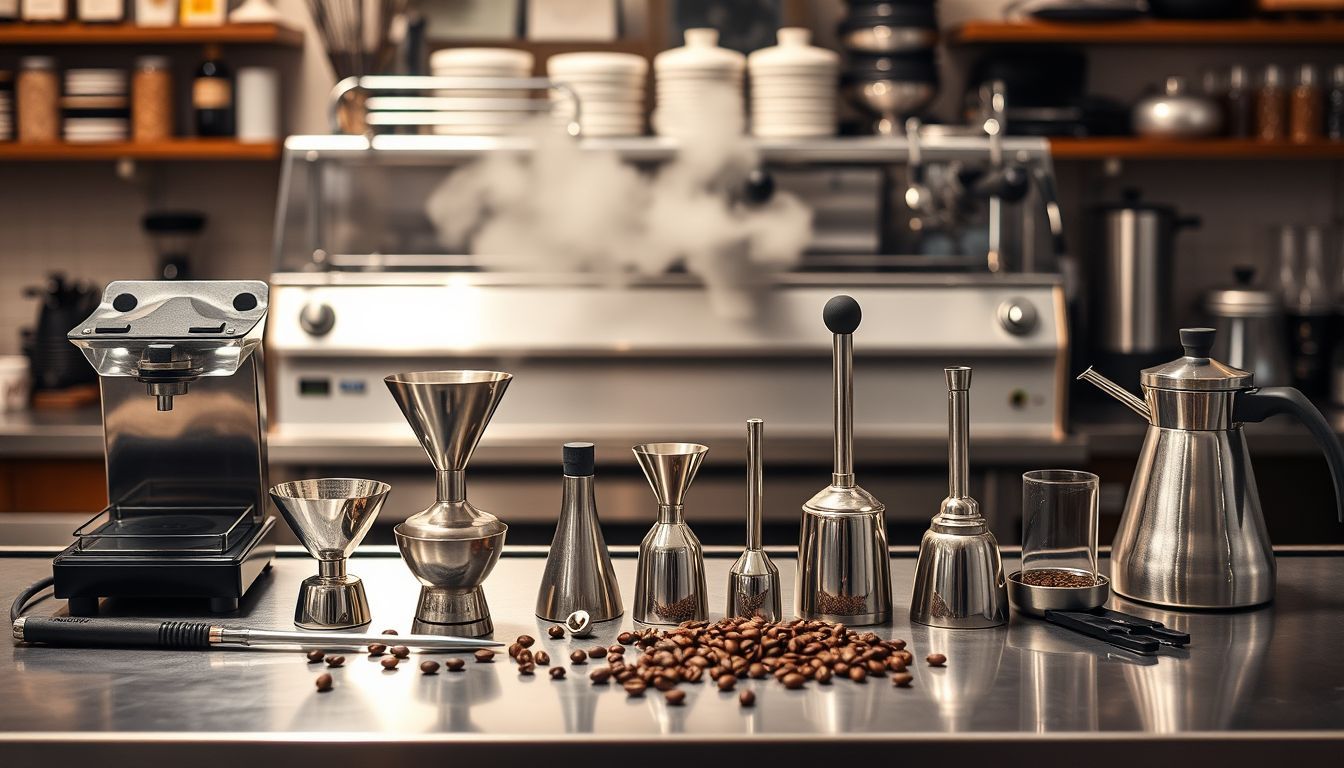Home Espresso Setup: Choosing the Right Equipment and Perfecting Your Brew
Build the perfect home espresso setup without breaking the bank. Expert analysis of machines, grinders, and techniques to create café-quality shots in your kitchen.

Amazon Affiliate Disclosure
This post contains affiliate links. If you purchase through these links, we may earn a small commission at no additional cost to you.
Home Espresso Setup: Choosing the Right Equipment and Perfecting Your Brew
Let me guess—you've been to that one café where the barista pulls shots with the precision of a Swiss watchmaker, and you've thought, "I could totally do this at home." Then you started researching espresso machines and suddenly found yourself in a rabbit hole deeper than Alice's, surrounded by terms like "PID controllers," "rotary pumps," and price tags that make your mortgage payment look reasonable.
Here's the truth: creating excellent espresso at home is absolutely achievable, but it requires understanding the relationship between equipment, technique, and expectations. After analyzing hundreds of home setups and testing equipment across every price range, I'm here to guide you through building a system that delivers consistently great shots without requiring a second mortgage.
Understanding the Espresso Equation
The Four Pillars of Home Espresso
Before we dive into specific equipment recommendations, let's establish the foundation. Great espresso relies on four critical elements:
- Quality beans (freshly roasted, properly stored)
- Consistent grinding (uniform particle size distribution)
- Precise extraction (temperature, pressure, timing)
- Proper technique (dosing, distribution, tamping)
Notice that only two of these require expensive equipment. The other two? Those are all about knowledge and practice.
The 80/20 Rule Applied to Espresso
Here's my analytical take: 80% of your espresso quality comes from your grinder and beans, while only 20% comes from your machine. Yet most beginners do exactly the opposite—they spend $800 on a machine and $150 on a grinder. This is backwards thinking that leads to frustration and mediocre coffee.
Grinders: The Unsung Heroes
Why Your Grinder Matters More Than Your Machine
Espresso demands consistency at a microscopic level. We're talking about particle sizes measured in microns, where even small variations can turn a perfect shot into either sour water or bitter sludge. A quality burr grinder doesn't just crush beans—it creates uniform particles that extract evenly under pressure.
Entry-Level Champions ($200-400)
A great entry-level choice is the Baratza Encore ESP Coffee Grinder, which provides the precision needed for espresso. Its design specifically targets espresso particle distribution, giving you a consistent foundation for your shots.
Eureka Mignon Specialita - Italian engineering at its finest. Quieter than many grinders, with stepless adjustment and excellent build quality. The flat burrs produce consistently uniform grinds.
Mid-Range Powerhouses ($400-800)
Niche Zero - The darling of home enthusiasts, and for good reason. Single-dosing design eliminates retention, meaning every bean you put in comes out ground. The stepless adjustment and conical burrs produce exceptional results across all brewing methods.
Eureka Mignon XL - Larger burrs than the Specialita, resulting in faster grinding and better particle distribution. The timer-based dosing is reliable once dialed in.
Professional Territory ($800+)
Mahlkönig X54 - Commercial-grade burrs in a home-friendly package. The grind quality rivals machines costing twice as much.
Weber Key - For the ultimate perfectionist. This grinder represents the current pinnacle of home espresso grinding technology.
Espresso Machines: Finding Your Sweet Spot
Entry-Level Excellence ($300-600)
Gaggia Classic Pro - The Honda Civic of espresso machines. Reliable, repairable, and capable of excellent results with proper technique. The commercial-grade portafilter and three-way solenoid valve put it ahead of most machines in this price range.
Breville Bambino Plus - Modern convenience meets solid performance. The automatic milk steaming is genuinely useful for beginners, and the pre-infusion feature helps with extraction consistency.
Mid-Range Marvels ($600-1200)
Rancilio Silvia - Built like a tank with commercial-grade components. The brass boiler provides excellent thermal stability, though the lack of PID means you'll need to temperature surf initially.
Breville Barista Express - Integrated grinder makes this an attractive all-in-one solution, though serious enthusiasts will eventually want to upgrade the grinder separately.
Prosumer Paradise ($1200-3000)
Rocket Appartamento - Italian aesthetics meet serious performance. The E61 group head and rotary pump provide commercial-level consistency.
Profitec Pro 300 - Dual boiler design allows simultaneous brewing and steaming. PID temperature control eliminates guesswork.
The Enthusiast Tier ($3000+)
La Marzocco Linea Mini - Essentially a commercial machine shrunk for home use. If you're serious enough to consider this category, you probably don't need my recommendations.
Building Your Setup: Budget-Conscious Strategies
The $800 Sweet Spot
- Grinder: Baratza Sette 270Wi ($400)
- Machine: Gaggia Classic Pro ($350)
- Accessories: Scale, tamper, distribution tool ($50)
This combination will outperform setups costing twice as much if you invest time in learning proper technique.
The $1500 Balanced Approach
- Grinder: Niche Zero ($700)
- Machine: Rancilio Silvia ($750)
- Accessories: Quality scale, precision tamper, WDT tool ($100)
This setup provides room to grow while delivering consistently excellent results from day one.
The $3000 No-Compromise Solution
- Grinder: Mahlkönig X54 ($1200)
- Machine: Profitec Pro 300 ($1700)
- Accessories: Professional tools and accessories ($100)
At this level, equipment limitations disappear, and results depend entirely on your skill and bean quality.
Essential Accessories: The Supporting Cast
Precision Tools That Matter
Digital Scale - Non-negotiable. You need 0.1g precision for consistent dosing. The Acaia Lunar is the gold standard, but a simple coffee scale with a timer provides 90% of the functionality at a fraction of the cost.
Distribution Tools - A Weiss Distribution Technique (WDT) tool breaks up clumps and ensures even distribution. You can make one with 3D-printed parts and acupuncture needles for under $20.
Quality Tamper - Your machine's included tamper is probably inadequate. A properly sized, flat-based tamper ensures even compression. A calibrated tamper offers excellent value and consistency.
Water: The Forgotten Variable
Espresso is 90% water, yet most home baristas ignore water quality. Ideal brewing water contains 75-150 ppm total dissolved solids with balanced mineral content. If your tap water tastes good, it's probably fine for espresso. If not, consider filtered water or remineralization systems like Third Wave Water.
Dialing In: The Art and Science
Understanding Extraction Variables
Espresso extraction follows predictable patterns:
- Grind finer = slower flow, more extraction
- Grind coarser = faster flow, less extraction
- More coffee = slower flow, potentially more extraction
- Less coffee = faster flow, less extraction
The 18:36 Starting Point
Begin with 18g of coffee targeting 36g of liquid espresso in 25-30 seconds. This 1:2 ratio provides a balanced starting point for most beans. Adjust grind size to hit your time target, then taste and modify ratio if needed.
Troubleshooting Common Issues
Sour shots typically indicate under-extraction. Try grinding finer, using more coffee, or increasing water temperature.
Bitter shots suggest over-extraction. Grind coarser, use less coffee, or decrease temperature.
Channeling (uneven extraction) usually results from poor distribution or inconsistent tamping. Focus on your prep routine.
Advanced Techniques: Elevating Your Game
Pre-infusion and Pressure Profiling
Many modern machines offer pre-infusion—a brief period of low-pressure water contact before full extraction. This helps even out the coffee bed and can improve extraction consistency.
Pressure profiling, available on high-end machines, allows you to vary pressure throughout the shot. While not necessary for excellent espresso, it opens up new flavor possibilities.
Temperature Stability and PID Controllers
Consistent temperature is crucial for repeatable results. Machines with PID controllers maintain temperature within 1-2°F, while non-PID machines can vary by 10-15°F. If your machine lacks PID, learn temperature surfing techniques to time your shots with optimal boiler temperature.
Maintenance: Protecting Your Investment
Daily Habits
- Backflush your machine after each session
- Purge the group head before brewing
- Empty and rinse the drip tray and water reservoir
- Wipe down all surfaces
Weekly Routines
- Deep clean your grinder burrs
- Descale if you have hard water (monthly for soft water)
- Replace water filters as recommended
The Economics of Home Espresso
Let's talk numbers. A quality home setup costs $800-1500 initially, but the per-cup cost drops dramatically. Assuming $15/lb specialty coffee yielding 30 shots, your coffee cost is $0.50 per double shot. Compare that to $4-6 café prices, and the math becomes compelling quickly.
Common Mistakes and How to Avoid Them
The Upgrade Trap
Many enthusiasts constantly chase equipment upgrades instead of perfecting technique. Master your current setup before considering upgrades. I've seen incredible espresso from basic machines operated by skilled users.
Neglecting Bean Quality
No amount of expensive equipment can salvage stale, poorly roasted beans. Invest in quality, freshly roasted coffee from reputable roasters. Use beans within 2-4 weeks of roast date for optimal results.
Inconsistent Routine
Espresso rewards consistency. Develop a repeatable routine for dosing, distribution, tamping, and timing. Small variations compound into significant taste differences.
The Learning Curve: Setting Realistic Expectations
Here's the honest truth: your first month of home espresso will probably be frustrating. You'll pull sour shots, bitter shots, and shots that somehow manage to be both simultaneously. This is normal. Professional baristas train for months to achieve consistency.
Expect to waste some coffee during the learning process. Consider it tuition for your espresso education. Keep detailed notes about grind settings, doses, and results. Patterns will emerge, and suddenly everything will click.
Beyond Espresso: Expanding Your Horizons
Milk-Based Drinks
Once you've mastered straight espresso, milk drinks open up new possibilities. Proper milk steaming requires practice, but the principles are straightforward: create microfoam through controlled air introduction, then heat without adding more air.
Seasonal Adjustments
Coffee beans change with humidity and age. Your grind settings will need regular adjustment—sometimes daily. Embrace this as part of the craft, not a frustration.
Conclusion: Your Journey to Espresso Excellence
Building a home espresso setup isn't just about buying equipment—it's about joining a community of passionate coffee enthusiasts who understand that the perfect shot is worth pursuing, even if it takes a few hundred imperfect ones to get there.
Start with a balanced approach: invest more in your grinder than your machine, focus on technique over gadgets, and remember that consistency beats complexity every time. The most expensive setup in the world won't make good espresso if you don't understand the fundamentals.
Your café-quality espresso journey begins with a single shot. It might not be perfect, but it's yours. And with the right equipment, proper technique, and a bit of patience, you'll soon be pulling shots that rival your favorite coffee shop—all while wearing pajamas and saving money.
Now stop reading about espresso and start making some. Your taste buds (and your wallet) will thank you.

Sofia Rossi
I started my career in a world of spreadsheets and boardrooms, but I quickly realized the most interesting data was in the way people interacted when the pressure was on. My novels are my way of analyzing the human heart—the messy, complicated, and often hilarious parts. I write about the lives we lead now, with all the love, ambition, and absurdity that comes with it.


